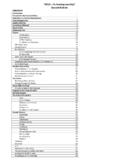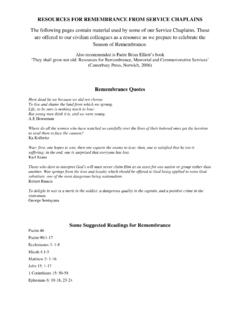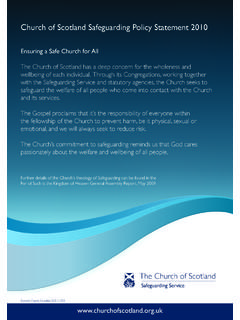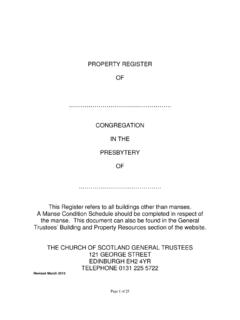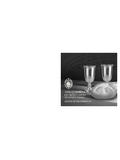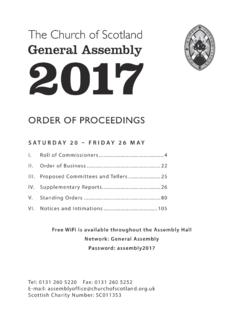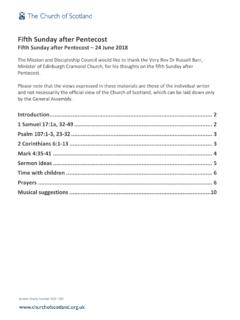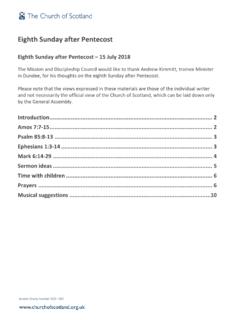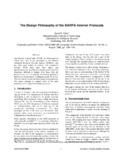Transcription of THE TRADITION OF THE LORD’S SUPPER - Church …
1 THE TRADITION OF THE lord S SUPPER By Peter Donald What is the place of the Sacrament of the lord s SUPPER in the Church today? I would like to pose the question in a contextualised mode, with reference to the Church of Scotland in 2005. What does the Sacrament of the lord s SUPPER hold out in promise and in practice? Fix a picture of the Sacrament of the lord s SUPPER in your minds. Which will it be? Of members of a congregation taking each a small cube of bread, drinking from a tiny glass, seated in pews covered in white cloths, with silence and planned formality? Of movement towards what might be the east end and different patterns of distribution? Of kneeling or standing? Of an informal circle, of certain pieces of music? Of a papal mass in the square of St Peter s? Of a San Salvadorean archbishop being gunned down during the Eucharistic prayer?
2 Of gold and incense in abundance? Of children being present and receiving the elements? All of these and any come into my mind, but I would like in particular to describe Clachan Church (Lochbroom) empty when I was last there, save for a few faithful souls on a Sunday afternoon who come together for a service without Communion. However, Clachan, near Ullapool, has an interior dominated by two long tables with benches which extend from front to back. The Communion memories therefore are both strong and highly visual, of invitations to come in around the table where bread would be passed round and wine drunk from large silver goblets, of an awe-inspiring action only for those who knew themselves to be well prepared over several days of preparation. The Communion season when it came affected the lives of everyone in that neighbourhood.
3 Ordinary life was suspended in a sense, for all that it was also undoubtedly a precious time of family and friends gathering and of rest from hard labours. It was it used to be a time to remember and to be shaped by. Over my lifetime, as far as I can tell, the Clachan Communion experience has almost died a death. I have no wish to over-romanticise it, since in a full analysis its history as well as the present would bear complex scrutiny, but it gives us a starting-point as good as any. What place does the Sacrament of the lord s SUPPER hold in today s Scotland? As the nurturing experience of the dying and rising of Jesus Christ, the Sacrament is accorded by a Church like our own a central role in its establishment, but there are many current questions in and around that. To take Clachan in 2005 as our starting-point, have we for example, for all that we uphold an ordained ministry of word and sacrament, become rather inclined to emphasise word more than sacrament?
4 Who all can participate in the Sacrament? How should it be administered? Such questions impinge not only upon local practice but are also of great significance in faith and order terms, alongside other churches, and furthermore in encounter with those who would challenge the rationale of Christian faith. Eucharistic understandings and questions of Church identity are deeply connected. They matter in the rural Highlands of Scotland as much as anywhere else. And as well as questions inwardly focused, it might further be asked, how significant is the Sacrament of the lord s SUPPER within the mission or witness of the Church ? To use modern terms, what is its interface with the world s agenda or, in more traditional speak, how is it a converting ordinance? I offer this paper, conscious that a wider process of reflection is getting under way on these very issues and with a heavy caveat that this paper is very preliminary in its form and research.
5 Decisions at the General Assembly to ask for comment on liturgical practice and, quite separately, to survey historic Communion plate, together with many discussions raising questions of ecclesiology, have underpinned a recent decision to prepare a major report on the place of the Sacrament of the lord s SUPPER within the Church of Scotland. I hope our discussions in Geneva will be helpful in the process. I. The inheritance, from past to present The Scriptural note of the Sacrament of the lord s SUPPER being a TRADITION handed on (cf. I Corinthians ) encourages an initial engagement with local inheritance, not least to enable wisdom in our contemporary handling of the issues at stake. In broad terms these issues might be clustered under four headings, drawn out of that insightful chapter of the first letter to the Corinthians namely the geography of liturgy, the social fabric, the dimension of witness and the theology and practice.
6 The geography of liturgy when you meet together as a group (I Cor. ) The geography of liturgy encompasses the gathering of the people and the external ordering of the Sacrament. There are issues of where and when we come together for the lord s SUPPER , including the design of Church interiors and furnishings. There have been various shifts of greater and lesser significance through Church history, and amongst these most prominently the institution of the lord s Day on a Sunday, the day of resurrection, and Church buildings. The scale of the meal being shared, the erection of stone altars and the modelling of building design also with reference to the Temple and/or architectural invention would give scope for comment, as would the history of vestments, of the use of music and incense and 1 icons. The TRADITION has been commented on and frequently argued over.
7 The frequency of Eucharistic celebration has also fluctuated, and the related issues of who participates when and how. For the Church of Scotland finding its identity as a particular reformed Church , the geography of liturgy gave clear markers. The altar was abandoned in favour of the table, and the east end in favour of sitting around the long table (as at Clachan, although usually in a less permanent design). This obviously had its bearing on Church architecture. Vocabulary changed and much else besides the dress of the Minister and his centre of operation (the pulpit being now used for teaching as well as for the reading of the Word); the decoration of the Church being altogether devalued; the music being simplified and popularised; the Communion plate changing in design; and the frequency of the lord s SUPPER generally settling down far away from every lord s Day, although when it did happen, it always implied the participation of the people as well as the one ordained to preside.
8 It matters to start here, since rhythms and externals are not without profound influence on people s sensibilities. Wars may be readily fought over such matters. Nevertheless, in the present day Church of Scotland, diversity very much has become the order of the day. In some parts of the Church , there is a desire largely to keep with what has been handed down to us, but elsewhere a restlessness for change is an obvious feature. Whether with furniture or decoration, liturgical form and style, there are many experiments. Clachan Church witnesses to times when the geography was more fixed. If one of the rare general conclusions to be drawn is that worship in the Church of Scotland nowadays follows few agreed lines, and that variety and a borrowing from various traditions is very much in vogue, what asks to be pondered specifically here is how this affects celebrations of the lord s SUPPER .
9 The geography be it timings or location, dress or design, Church furniture, the use of symbols and music and the pattern of the spoken word contributes to people s expectations and experience. Behind the debate about the degree of formality that is appropriate and over what can or should drive change, for instance over issues of human comfort and communication, ultimately is it not rather important to discern how precisely space, or time, becomes sacred, the meeting-point between heaven and earth, and so to keep the geography of liturgy issues within the most sound perspective? Social Fabric opposing groups (I Cor. ) The social fabric heading is to take on board in the first instance issues which were of key significance in Christianity at its beginnings namely the composition of the Church where, finding its identity around both Word and Sacrament, all sorts of people came together.
10 The breaking down of social barriers, whether between Jew and Gentile, slave and free, men and women, was arguably fundamental. Secondly, in respect of the Church s place within society, an appreciation is needful of how the Church defines itself within the culture of its day shaped by a variety of forces. The early Church needed to accept that in the eyes of the world they were a sect, but after Constantine this changed radically, to an extent ultimately that the outsiders, the deviants even, were those who did not come in to the Church . For the Church of Scotland, while the age-old problems of social distinctions being maintained somewhat in the face of Christian doctrine have probably been more of a challenge in days past than nowadays, in respect of its national establishment, however, and the pursuit of the goal of a covenanted nation, there continue to be some unresolved issues.
